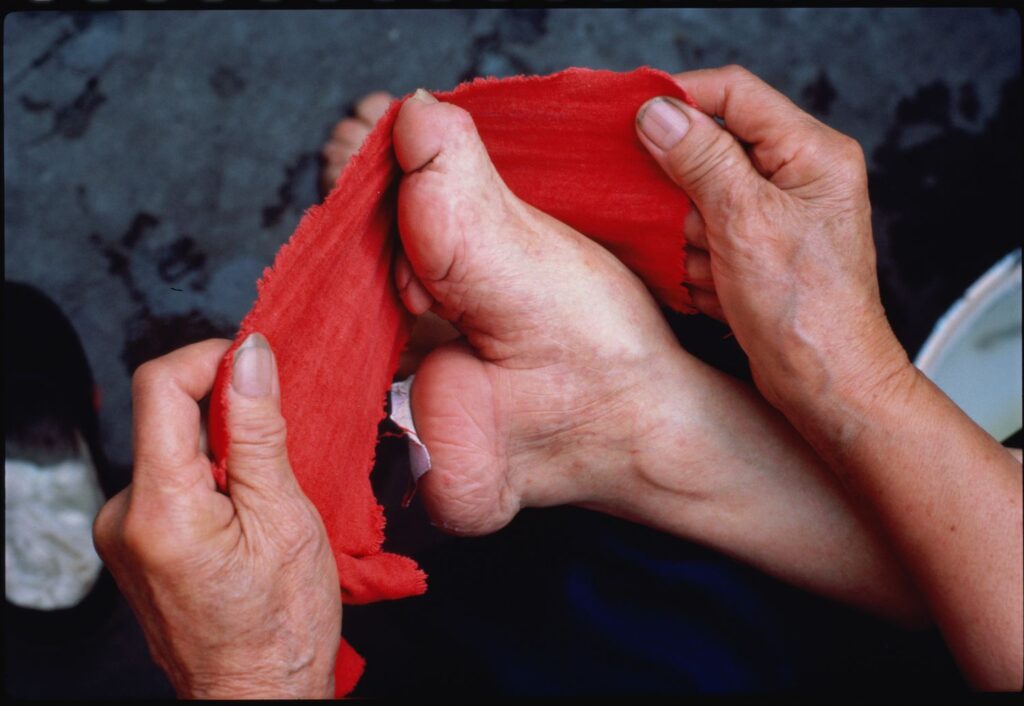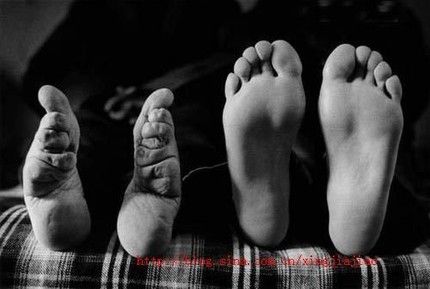The consequences of binding the feet of the young girls caused a lifetime of deformity and permanent disfigurement or even an early death In some cases, an early death was inevitable due to unbearable pain or an acquired disease caused by the process being poorly administered. In the 19th century, the tradition was popular even amongst the people in the countryside. Colin Mackerras in his book review “Footbinding as Fashion: Ethnicity, Labor, and Status in Traditional China” said footbinding involved binding the feet of small girls to prevent them from growing and aimed to keep them as small as possible, the “three-inch foot” being the desired standard. The feet were placed in hot water. The toenails were clipped and a massage was given. Oil was then administered and spread all over the foot. To start the bending process, the smaller toes were broken except for the big toe and pressed under the sole fashioned into a triangle shape. The arches had to be strained. The feet were bound and wrapped in a measured silk strip. The feet were kept clean to prevent gangrene or a variety of other diseases. It was a difficult task. The wrappings had to be removed every few days for the feet to be washed. In the YouTube documentary, EWU History analyzed, “If there were any excess skin or nail out of the desired triangle shape of the lotus, it would be cut off with a knife or measures were taken to make sure those pieces rotted and fell off”. The girls were forced to walk on their bound feet to make sure their arches were broken. The whole process took nearly three years to complete.

(figure 1)
As seen in the photo (figure 1) the women aimed to achieve a high-heel-like shape. The pain the girls experienced for the first two years was barely tolerable but as time passed their toes became used to the pain. Due to the ordeal of footbinding, the women suffered from a lifetime of pain, regret, and permanent disfigurement. The consequence was a mortal eternity of physical deformity. The women suffered brittle bones and numerous foot problems. A case was reported of a 99-year-old woman being admitted to the emergency department due to a fall. A radiograph was obtained and the images showed deformity and extremely reduced-sized feet resembling baby feet. The findings consisted of foot binding in childhood. In another instance, EWU History spoke, “91 years Pi Shi shows an interviewer the severe ways her feet were bound to reshape them. Even after all these years, she can’t forget the agonizing pain and suffering that she had to endure as her feet were broken and bound. For the rest of her life, she lived in pain, all in the name of beauty.”.The young girls and the remaining survivors who endured the excruciating process of footbinding were all destined for a lifetime of pain. However, by the mid-twentieth century, the practice was finally outlawed.
The outlawed Practice has made the Last Surviving Generation a Target of Public Ridicule. Since the time footbinding began, attempts to outlaw footbinding were made but through all those attempts the women were humiliated and mocked. However, It wasn’t solely the women’s fault that the practice persisted for so long. It was encouraged by the culture itself. Theoretically, historians believed it was more than about making a good marriage but the practice may have been encouraged since it limited how far they were able to leave their homes. They could not move with ease and so it helped them to keep their chastity. The latest research suggests the lack of mobility correlates with women being expected to help their families and husbands economically by handcrafting items and other daily necessities. The process severely restricted their mobility. In the article “Why Footbinding Persisted in China for a Millennium” Foreman comments, “The act of foot-binding—the pain involved and the physical limitations it created—became a woman’s daily demonstration of her own commitment to Confucian values.” The women might have been part of the reason and the ones to administer the process on their children but you can see why it was done and where the trajectory of their state of mind lay. Nonetheless, the immense amount of pain they endured was utterly disregarded. They had become subject to public opinion and mockery because of their small feet, especially for Chinese women in the 1930s. They were cruelly treated and abandoned. If spotted in the streets with bound feet, people would rip and cut their bindings, exposing their covered feet. They were humiliated and criticized (“The Horrors Behind Foot Binding”). However, their suffering wasn’t in vain. The remaining survivors of footbinding, the last of their generation, gained fame. According to EWU History, they have gone as far as creating a troupe group called The Bound-Feet Disco Dancing Troupe. A sense of pride remains instilled within the hearts of the last surviving generation. In essence, the Chinese women were taught that a prevailing marriage was imperative. They believed it was vital to be a good wife and serve their husbands because the practice of footbinding demonstrated a woman’s willingness and submission to her husband. Although the consequences of binding their feet caused a lifetime of pain and permanent disfigurement, the practice, originally inspired by Yao-Niang, has long been outlawed. The past is history and history is ever-lasting memories. Footbinding in China is now a memory of the past.


